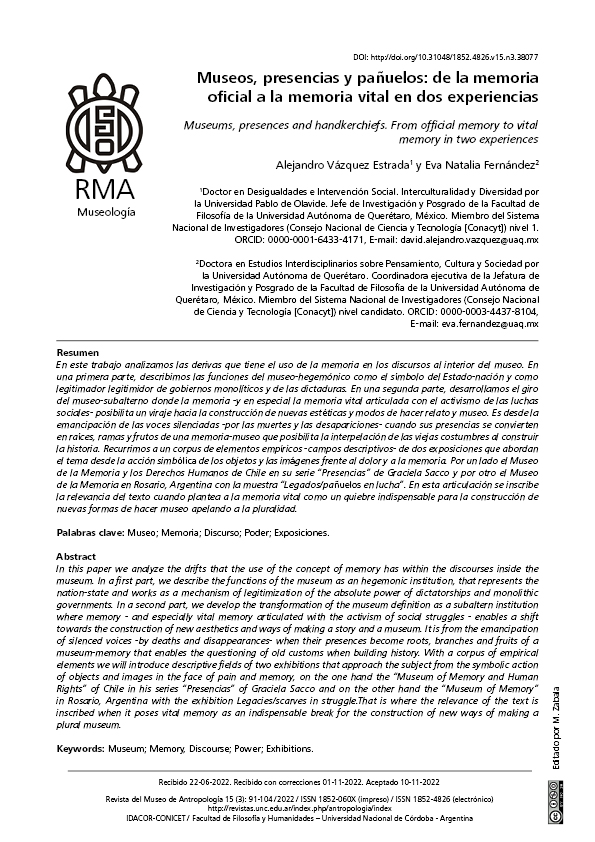Museums, presences and handkerchiefs. From official memory to vital memory in two experiences
DOI:
https://doi.org/10.31048/1852.4826.v15.n3.38077Keywords:
Museum, Memory, Discourse, Power, ExhibitionsAbstract
In this work we analyze the drifts that the use of memory has in the discourses inside the museum. In a first part, we describe the functions of the hegemonic museum as a representative of the nation-state and as a legitimizer of the absolute power of dictatorships and monolithic governments. In a second part, we develop the turn of the museum-subordinate where memory - and especially vital memory articulated with the activism of social struggles - enables a shift towards the construction of new aesthetics and ways of making a story and a museum. It is from the emancipation of silenced voices -by deaths and disappearances- when their presences become roots, branches and fruits of a museum-memory that enables the questioning of old customs when building history. With a corpus of empirical elements we will introduce descriptive fields of two exhibitions that approach the subject from the symbolic action of objects and images in the face of pain and memory, on the one hand the "Museum of Memory and Human Rights" of Chile in his series “Presencias” of Graciela Sacco and on the other hand the “Museum of Memory" in Rosario, Argentina with the exhibition Legacies/scarves in struggle.That is where the relevance of the text is inscribed when it poses vital memory as an indispensable break for the construction of new ways of making a plural museum.
Downloads
References
Anderson, Benedict. (1993). Comunidades imaginadas. Reflexiones sobre el origen y la difusión del nacionalismo. D.F., México: Fondo de Cultura Económica S.A. de C.V.
Barreto, Margarita. (2014). “Los museos y su papel en la Formación de la identidad”. Recuperado 15 octubre 2014 de: http://www.naya.org.ar/ articulos/identi02.htm
Camargo-Moro, Fernanda. (1982). “Museos, patrimonio y políticas culturales en América Latina y el Caribe” en Museum Vol. XXXIV, Nº 2, Museos, patrimonio y políticas culturales en América Latina y el Caribe, Suiza: Unesco.
Camacho, Rosa Elba. (2010). “El museo ante la comunidad. Nuevas Rutas en lo mustela: ejemplos y referentes”, Intervención, Año 1, Num 2., 8-15.
García Canclini, Néstor. (1997). Culturas Híbridas y Estrategias Comunicacionales. Estudios sobre las Culturas Contemporáneas, Vol III,109-128.
De Certeau, Michel. (1996). La invención de lo cotidiano 1. México: Universidad Iberoamericana.
De Sousa Santos, Boaventura. (2010). Para descolonizar occidente. Más allá del pensamiento abismal. CLACSO, 2010.
Didi Huberman, George. “.(2011)La exposición como máquina de guerra”, en Minerva: Revista del Círculo de Bellas Artes, nº 16, 24-28.
Fernández Domingo, Enrique. (2018). “Les filiations discursives du Museo de la Memoria y los Derechos Humanos de Santiago du Chili”, dans Dalila Chine Lehmann et Natalia Molinaro (ed.), La Nation en fête en Amérique latine (XIX-XXI siècles) TomeII/Festejando la Nación en América Latina (siglos XIX-XX) Tomo II, Publications du GRECUN-Université de Paris Nanterre, Nanterre, 189-202.
Foucault, Michel. (1971). El orden del discurso. Buenos Aires: Tusquets Editores S.A.
Foucault, Michel. (1967). La arqueología del saber. Buenos Aires: Siglo XXI Editores.
Haesbaert, RogÛrio. (2013). “Del mito de la desterritorialización a la multiterritorialidad”. Cultura y representaciones sociales, Volumen 8, (Nº15), 9-42. Recuperado en http://www.revistas.unam.mx/index.php/crs/article/view/41590/37807
Hirch, Marianne. (2012). The generation of postmemory. Writing and visual culture after the Holocaust, Nueva York: Columbia University Press.
ICOM. (2022). Recuperado en: https://icom.museum/wp-content/uploads/2022/07/EN_EGA2022_MuseumDefinition_WDoc_Final-2.pdf
Jaramillo F. C. (Febrero de 2007). El Caso del Museo de Antioquia. Recuperado el 26 de mayo de 2014 desde: http://www.uv.es/museos/ MATERIAL/Jaramillo.pdf.
Jiménez-Blanco, María Dolores. (2014). Una historia del museo en nueve conceptos, Madrid: Ediciones Cátedra.
Kalenberg, Ángel. (2011). “Los museos de América Latina en escena”, en Una teoría del arte desde América Latina, Jiménez, José (Ed.), Madrid: MEIAC/Turner.
Koolhas, Rem. (1997). La ciudad genérica, España: Ed Gustavo Gili, SL.
Lacouture Fornelli, Felipe. (2003). Museos, sociedad y poder. Gaceta de Museos INAH, Volumen 28.
Lefebvre, Henri. (2013). La producción del espacio. Madrid: Capitán Swing.
Medina, Cuauhtémoc. (2017). Abuso mutuo. España: Editorial R.M.
Museo de la memoria y los derechos humanos, web, 2021. https://web.museodelamemoria.cl/informate/exposiciones/quien-fue-de-graciela-sacco/
Museo de la memoria, web, 2021. https://www.museodelamemoria.gob.ar/page/muestras/id/71/title/Legados-%7C-Pañuelos-en-lucha
Pinochet Cobos, Carla. (2016). Derivas críticas del museo en América Latina, Siglo veintiuno editores, Serie Zona Crítica: México.
Pomian, Krzysztof. (1987). “La colección, entre lo visible y lo invisible”, en Collectioneurs, amateurs, curieux, París: Gallimard.
Richard, Nelly. (2010). Crítica de la memoria (1990-2010), Chile: Ediciones Universidad Diego Portales.
Revel, Jacques, “La fábrica del patrimonio”, TAREA, Anuario del Instituto de Investigaciones sobre el Patrimonio Cultural, Año 1, CABA: Unsam, 2014.
Rolnic, Suely. (2007).“La memoria del cuerpo contamina el museo”. Recuperado en http://eipcp.net/transversal/0507/rolnik/es
Silverman, Lois H. (2014). “Los museos en una nueva era: los visitantes y la construcción de significado”. Recuperado el 26 de mayo de 2014, desde:http://www.ilam.org/ILAMDOC/visitantes-construccion-significado.pdf
Van Dijk, Teun. El análisis crítico del discurso. Barcelona: Antrophos, 1999.
Ventura Xavier & Arrieta Urtizberea Iñaki. (2010). “Construcción de identidades en los museos de Cataluña y País Vasco: entre lo local, nacional y global”. Revista: PASOS. Revista de Turismo y Patrimonio Cultural. 8(4), 539-553.

Downloads
Published
Issue
Section
License
Copyright (c) 2022 Eva Fernández

This work is licensed under a Creative Commons Attribution-NonCommercial-ShareAlike 4.0 International License.
Those authors who have publications with this Journalaccept the following terms:
a. Authors will retain their copyrights and guarantee the journal the right of first publication of their work, which will be simultaneously subject to the Creative Commons Attribution License (Licencia de reconocimiento de Creative Commons) that allows third parties to share the work as long as its author and his first publication in this journal.
b. Authors may adopt other non-exclusive licensing agreements for the distribution of the version of the published work (eg, deposit it in an institutional electronic file or publish it in a monographic volume) provided that the initial publication in this journal is indicated.
c. Authors are allowed and recommended to disseminate their work on the Internet (eg in institutional telematic archives or on their website) before and during the submission process, which can lead to interesting exchanges and increase citations of the published work. (See The Effect of Open Access - El efecto del acceso abierto)











